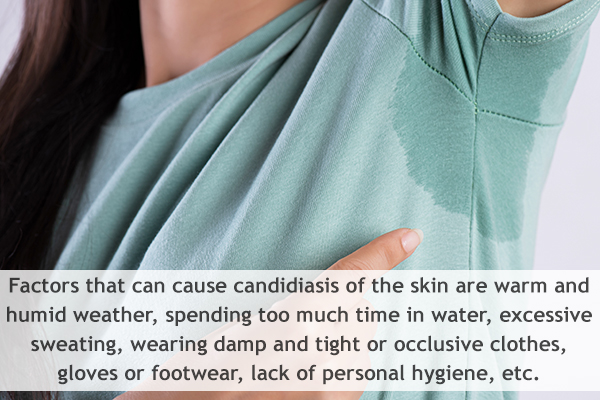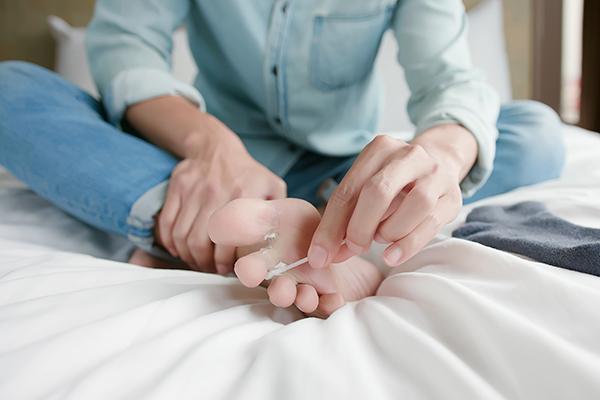In this article:
Human skin is naturally populated with a variety of bacteria and fungi that together constitute the commensal skin microbiota. These microbes do not cause any harm to the body so long as they don’t overgrow, in which case an infection may occur.

Unclean skin is a perfect breeding ground for such infections as it collects dead cells and excess sebum that provide sustenance to these microbes, allowing them to multiply rapidly.
One such fungal skin infection is candidiasis of the skin, also known as cutaneous candidiasis. It can affect people of all ages, from babies to adults, but does not spread from one person to another.
The good thing is cutaneous candidiasis can easily be managed with the right medical treatment and some simple self-care measures when the condition is still nascent.
How Common Is Cutaneous Candidiasis?
Skin infections caused by candida, commonly known as yeast, are quite common. In fact, 20%–25% of the world population is affected by fungal skin infections, (1) and candida infections account for a lot of these cases.
Causes and Risk Factors

Candidiasis is a yeast infection caused most commonly by the fungus Candida albicans but can also be caused by other Candida species. (2) The problem usually starts when candida grows rapidly.
Candida usually resides in the moist or damp areas of the skin such as skin folds. These areas of closed overlapping skin tend to collect a lot of heat, sweat, sebum, and dead cells.
The warmth, humidity, and organic debris favor the proliferation of the fungi, which then form a biofilm, colonize the skin, and give rise to an infection characterized by rashes in the affected areas. (3)
The following factors can cause these commensal fungi to proliferate, thereby putting you at risk of an infection:
- Warm and humid weather
- Spending too much time in the water
- Excessive sweating (hyperhidrosis)
- Wearing damp and tight or occlusive clothes, gloves, or footwear
- Wearing clothes made of poor-quality fiber that irritates the skin frequently (irritant contact dermatitis)
- Lack of personal hygiene
- Wearing damp, unclean undergarments or not changing them regularly
- Being bedridden
- Obesity (4)
- Pregnancy
- Medical conditions that compromise the immune system such as HIV/AIDS or disturb the hormonal profile such as thyroid or Cushing’s disease (5)
- High levels of blood glucose, which acts as food for the yeast and helps it grow
- Medications such as birth control pills, antibiotics that disturb the natural ecology of candida naturally present on and in the body, or those that weaken the immune system such as systemic corticosteroids (6)
- Cancer treatment such as chemotherapy (5)
- Age
Signs and Symptoms of Cutaneous Candidiasis
The main characteristic symptom of cutaneous candidiasis is the development of red, itchy rashes, usually within skin folds (candida intertrigo), (7) which may spread to other parts of the body.
The common sites of infection are the groin, foreskin of an uncircumcised penis, web between fingers and toes (erosio interdigitalis blastomycetica), armpits (axillae), area under the breasts, folds of the buttocks, nails (onychomycosis), and even mouth.
This rash is often accompanied by the following:
- Cracking or scaly skin
- Skin sores
- Pruritus or itchy skin
- Macerated plaques
- Superficial satellite papules or pustules
- Swelling
- Brittle nails
- Splitting nails
- Nail discoloration
- Infected hair follicles that resemble pimples
Medical Treatment for Cutaneous Candidiasis

Cutaneous candidiasis can be confused with several other skin disorders that present similar symptoms, such as ringworm (also a fungal infection but caused by a different species), herpes, seborrheic or contact dermatitis, hives, eczema, and psoriasis.
Therefore, you need a confirmed diagnosis before initiating medical treatment. Your doctor will recommend the suitable interventions and skin care measures based on the location and severity of the infection.
- Keeping the skin dry and ventilated is recommended, but if you can’t keep it open at all times, consider using drying or absorbent powders to soak up the sweat that forms in the area.
- Several antifungal ointments, lotions, or dusting powders with ingredients such as ketoconazole, miconazole, nystatin, clotrimazole, and oxiconazole might be suggested. (8) These are also available without a prescription, but the strength of these formulations is generally too low to combat severe infections. The expert will decide on the strength of the medication depending upon the diagnosis.
- Both topical and oral agents are available for the treatment of fungal nail infection. The most commonly used oral drugs for onychomycosis are griseofulvin, terbinafine, itraconazole, and ketoconazole. Topical medications include antifungal ointments and medicated nail lacquers with agents like ciclopirox and amorolfine. (9)
- If your mouth, throat, or vagina becomes infected with candidiasis, the doctor will recommend certain oral medications such as antifungal lozenges or mouth paints. Antifungal suppositories might also be suggested to treat vaginal thrush. Some general side effects that can be experienced include itching, mild redness, or rashes.
- Severe, generalized, and/or refractory cases may require oral antifungal treatments such as fluconazole (10) or itraconazole.
- Your doctor might advise biotin supplementation to treat brittle nails caused by a severe candida infection. Other treatments include those that treat or manage any underlying medical disorder that might be putting you at the risk of cutaneous candidiasis such as diabetes.
- Although very uncommon, some babies are born with this infection, in which case it is referred to as congenital cutaneous candidiasis. They contract the fungus from their mother’s genital tract while still inside the womb, and the infection starts manifesting symptoms within 6 days after delivery. The severity of the condition can range from localized skin infection to a systemic illness that affects multiple organs and cause life-threatening complications such as breathing problems, sepsis, and even death. While the former can usually be addressed through topical antifungal therapy, the latter will require more intensive treatment. (11)
- If you develop lesions on the infected skin, gently wipe the area with benzoyl peroxide or Castellani stain before applying any topical antifungal.
Diagnosing Cutaneous Candidiasis
The diagnosis is made after a proper examination of the symptoms and an assessment of the patient’s medical history.
The doctor may obtain a sample of the affected skin, nail clippings, or hair and send it for microscopic evaluation to look for fungal elements. This will confirm what type of infection you have and what species is causing it.
A direct potassium hydroxide smear can also help diagnose candida infection. The doctor may also test your blood sugar levels to rule out diabetes, which is a major risk factor that can worsen your condition.
Complications of an Untreated Cutaneous Candidiasis

Cutaneous candidiasis can become more serious, especially in people with compromised immunity. Some complications that may arise include:
- Spread of the infection to other parts of the body
- Candidemia or invasive candidiasis, wherein the yeast enters the bloodstream through an open cut or crack in the skin and causes lethal infections at various possible sites such as the heart, brain, bones, and eye (ocular infection)
- Development of post-inflammatory pigmentation that can sometimes take over 18 months to clear unless the inflammation is treated
- Scarring of the skin
- Discoloration and deformation of the nails
- Pain
- Thickening of the nails and nail dystrophy
- Vaginal thrush
- Oral thrush
- Secondary bacterial infections
When to See a Doctor
Yeast infections of the skin should immediately be reported to a doctor to nip them right in the bud. Attempting self-treatment of such conditions is ill advised.
Delayed or incorrect treatment can worsen the infection and give rise to a more serious condition or complications. Prompt treatment becomes even more crucial for high-risk individuals with medical conditions that have been mentioned above such as diabetes.
Other signs and symptoms that warrant immediate medical intervention include:
- Sudden development of the infection
- Fissuring skin
- Itching
- Burning sensation
- Tenderness
It is also important to take note of any recurrence and report it to your doctor.
Final Word
If treated in a timely and appropriately, most cases of cutaneous candidiasis typically resolve without any complications. But these infections have a tendency to recur.
Therefore, you must adhere to basic personal hygiene measures even after recovery to prevent fungal regrowth. This is especially important for high-risk individuals such as those who are overweight or diabetic as they are more likely to contract such skin infections.
- Was this article helpful?
- YES, THANKS!NOT REALLY


